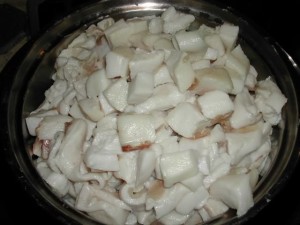Ciao a tutti!
Many people who travel to Italy and do not know the language can often buy products with ingredients in them that they are not aware of. Even people who are well versed in the language may mistakenly read a food label.
For example, there are many different ways to say sugar or salt, just to name a few. Knowing that sugar can be labeled sweetener or salt is also labeled sodium, can help us find products without those ingredients in them, if that is what we choose.
But there are also many different ways to say lard. Lard is basically animal fat or sometimes more specifically, pork fat. For a vegan it is essential that we understand this word and any derivatives of it.
Lard can be found in many products in Italy including:
- breads
- cookies
- snack cakes
- crackers
- pizza crust/frozen pizzas
- microwave meals
- ready-made/frozen meals
- soups
This unappetizing substance can be found under words such as:
- Lardo – bacon-fat
- lardo di colonnata – “high quality” fat
- lardello di maiale – pork fat
- Sugna – pork fat
- Strutto – lard
These words are important to know on labels, but you also have to be real careful eating out. Many, many traditional Italian kitchens use lard in their recipes, whether it is for making the pizza dough or making cakes. Below is a video (in Italian) from a traditional pizzeria from Naples. He uses strutto in the pizza dough. For those of you wishing to know when he says it, it’s at 34-35 seconds, listen for olio extra virgine (extra virgin olive oil), then strutto.
This chef also uses strutto and milk in his gluten-free pizza Margherita. In theory, traditional pizzas from Naples should not contain lard, because as in the pizza making world, this is a “trick” to make the dough softer and many chefs should not use it in their pizza dough.
One general tip: the softer the pizza crust, the more chance is that they used lard.
Anyhow, if they pre-make all the pizza dough in the morning (which usually they do), make sure it doesn’t have the strutto. Although the dough shouln’t contain lard, in some of the regions of the Italian countryside, such as Abruzzo, Molise, Campania – where there is still a strong tradition of farming – you may find it in many more recipes in general.
Remember, every chef has a different way of preparing food and unless you are familiar with the traditional kitchens and recipes of Italy, you will never know what is in your food! Regions change, cooks change and ingredients change.
Italy is vegan friendly if you know what to look for.

